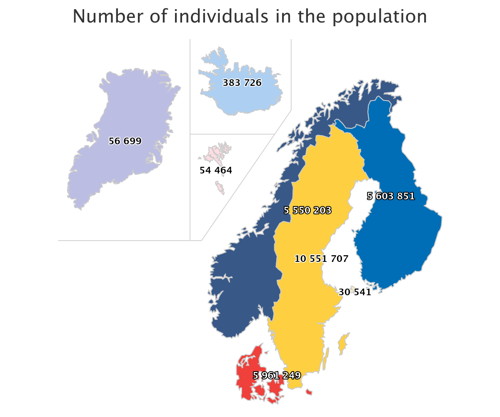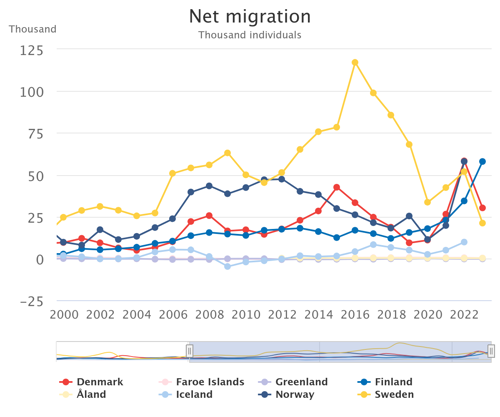Population growth in the Nordics
On January 1st, 2024, the Nordics had a total of 28.2 million registered residents, an increase with 0.6% compared with 2023. All eight Nordic countries experienced population growth between January 1st 2023 and the same date in 2024, with between 0.2 and 2.3 percent. This was mainly due to positive net migrations, although half of the countries also experienced a positive natural population increase.
There are four components to population change: live births, deaths, immigrations and emigrations. The difference between live births and deaths is called natural population increase. If there are more live births than deaths, it is positive, otherwise negative. Net migration is calculated as immigrations minus emigrations, and can also be positive or negative, depending on the sizes of the two flows.
So, the population of a country can increase in one or two ways, either there are more births than deaths or more immigrants than emigrants, or both.
Population size January 1st 2024
The total Nordic population, on January 1st, 2024, was 28.2 million.

Source: Nordic Statistics Database, POPU01
Population change
All eight Nordic countries; Denmark, Faroe Islands, Greenland, Finland, Åland, Iceland, Norway and Sweden, had population growth in 2023. The population of Iceland grew the most, by 2.3%, while Greenland had the smallest increase with 0.2%. Together, this gave a total increase of the Nordic population by 0.6% in 2023.

Source: Nordic Statistics Database, POPU01
In the past two decades, all eight countries have had population growth, but the size of that growth varies. Compared with the year 2000, the population of Iceland has grown the most, it has increased by around 35%. The increase in Norway during the same period is 23%, in Faroe Islands, Sweden and Åland it is 19%, in Denmark 11%, Finland 8% and in Greenland 1%.
This gives a combined growth of the Nordic population by 6%, compared to just over 4% in the EU (2022, 2023 value not yet available).

Source: Nordic Statistics Database, POPU10
Natural population increase
Three of the seven countries for which data on births and deaths are available for 2023 had a negative natural population increase, meaning more deaths than births. For Denmark and Åland, it was marginally negative, but for Finland it was significant, they had almost 18,000 more deaths than live births. Norway, Sweden, Faroe Islands and Greenland has positive natural population increase in 2023.
The countries have been divided into two groups, by number of births and deaths, in the figure below, for visibility. Please note that the scale differs between the two groups. No 2023 data is available for Iceland at this point in time.

Source: Nordic Statistics Database, CHIL01 and DEAT04
Net migrations
Data on immigration and emigration in 2023 is available for six of eight countries at this point in time. Of those six, only Greenland had a negative net migration, meaning that more people moved from than to the country.
For the three countries with a negative natural population increase, Denmark, Åland and Finland, this means that their populations grew because more people immigrated than emigrated.
As mentioned above, Finland had almost 18,000 more deaths than live births, but this was offset by the fact that they had 58,000 more immigrants than emigrants. This is the largest net reported for Finland in the past 25 years, and almost 70% higher than the second largest net from 2022.
Faroe Islands, Norway and Sweden had both positive natural population increase and net migration. For Sweden, the net migration was however the lowest in the 25 years analysed, roughly a fifth of that of 2016 when immigrations to Sweden peaked.

Source: Nordic Statistics Database, MIGR03